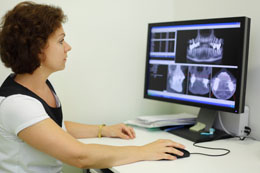An infection of the bones or osteomyelitis can lead to several complications, if not treated on time. Therefore, it is important to identify and treat this condition promptly. Its symptoms, as well as the causes are explained in this article.

The medical term for an infection of the bone is osteomyelitis, which can affect the bones of any part of the body. Accordingly, the condition can produce different symptoms depending on the location of the infected bone. So, if the jawbone gets infected, symptoms like pain and swelling can be evident in the mouth and the jaw area. However, the basic symptoms of osteomyelitis are same. An infection of the bone is usually caused by bacteria, but sometimes, fungi and other microorganisms can also be responsible for causing the infection.
Causes of Osteomyelitis
As mentioned already, a bone infection is usually caused by bacteria. More commonly, it is caused by the bacteria,
Staphylococcus aureus. Other microorganisms like Group A and B
Streptococcus,
Enterobacteriaceae,
Escherichia coli,
Haemophilus influenzae and
Salmonella also can cause this condition. Sometimes, an infection of the tissues that surround the bones can eventually spread to the bones.
Even infections from other parts of the body, such as an infection of the urinary tract can spread to the bones through the bloodstream. A severe traumatic injury to the bones that causes the specific bone to protrude through the skin can also cause an infection. Sometimes, orthopedic surgeries such knee replacement or hip replacement surgeries, wherein metal rods or plates are placed in the affected bone can cause osteomyelitis. Conditions like diabetes and peripheral arterial disease can raise the risk of this condition.
Symptoms of Osteomyelitis
Though osteomyelitis can affect bones of any part of the body, the long bones of the leg and the upper arm, and the bones of the spine are more likely to get infected. Osteomyelitis of the long bones of the arm and the legs is more common among children, while in adults, the bones of the spine are more likely to get infected. The most common symptoms of this condition are, bone pain, swelling, redness and warmth on the affected area. If the infection affects the leg bone, you can observe swelling in the ankle, foot, and the legs, along with pain and redness.
If an infection develops in the jawbone or in the mouth, then a few additional symptoms can be observed. A jawbone infection can be caused by periodontal disease and dental procedures like tooth extraction. The symptoms of this condition are, jaw pain and numbness. If it is associated with periodontal disease, then tooth loss and pus or drainage from the gums can occur.
Apart from the usual symptoms of pain and swelling, a bone infection can cause general discomfort or malaise, fever, excessive sweating, and chills. Fever is more commonly observed in children. Children suffering from osteomyelitis can become easily irritable and lethargic. If the infection of the surrounding tissues spread to the bone, then it can cause the buildup of pus and abscess in the area. Sometimes, pus-like fluid can come out from the skin as well. Adults with osteomyelitis can also experience back pain. A severe infection can weaken and damage the affected bone, and cause breakage.
Treatment for Osteomyelitis
It is usually treated with antibiotics. Along with antibiotics, the affected area needs to be cleaned surgically, especially when pus or abscess develops in the area. This is known as surgical debridement. Along with the pus or fluid, the infected tissues and the diseased part of the bone are also removed in this procedure. Sometimes, amputation can be required to prevent the infection from spreading further.
Osteomyelitis needs to be treated promptly, as it can lead to complications like bone death and septic arthritis, if left untreated. In children, an infection of the bone can also impair normal growth. To prevent such complications, the symptoms of this condition should be brought under the notice of a physician as soon as possible.
Disclaimer:
This article is for informative purposes only, and should not be treated as a substitute for professional medical advice.


 The medical term for an infection of the bone is osteomyelitis, which can affect the bones of any part of the body. Accordingly, the condition can produce different symptoms depending on the location of the infected bone. So, if the jawbone gets infected, symptoms like pain and swelling can be evident in the mouth and the jaw area. However, the basic symptoms of osteomyelitis are same. An infection of the bone is usually caused by bacteria, but sometimes, fungi and other microorganisms can also be responsible for causing the infection.
The medical term for an infection of the bone is osteomyelitis, which can affect the bones of any part of the body. Accordingly, the condition can produce different symptoms depending on the location of the infected bone. So, if the jawbone gets infected, symptoms like pain and swelling can be evident in the mouth and the jaw area. However, the basic symptoms of osteomyelitis are same. An infection of the bone is usually caused by bacteria, but sometimes, fungi and other microorganisms can also be responsible for causing the infection.